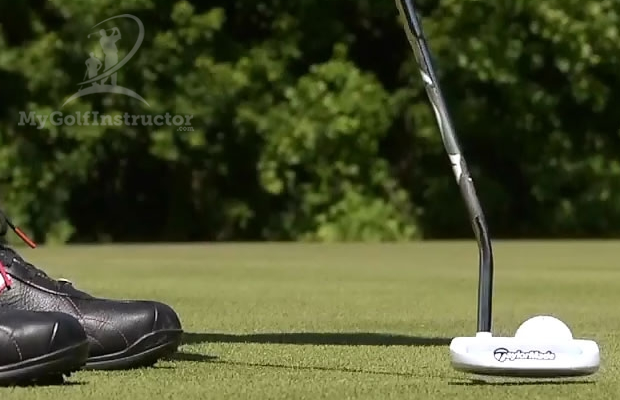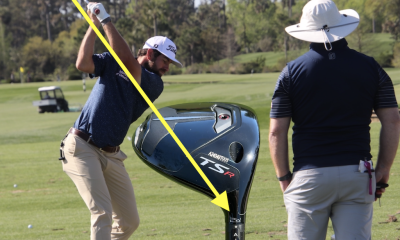Instruction
Palozola: The 5 Principles of Putting

So, your putting is pretty good. What? Really? Is that what you actually tell people? Well, that means that you must be averaging in the high 20’s for putts per round, because that’s what the leaders on tour are doing. At the time of this writing the leader on the PGA Tour is averaging 27.36 putts per round and the worst putter on tour is averaging 30.88 putts per round. Now that’s “good” putting!
Having taught players of all skill levels for 20 years I have come to two conclusions about putting:
- Way more people come to the lesson tee and say that they are good putters than say they are bad putters.
- Just about zero of them are actually “good.”
The perception of what it means to be a good putter is strongly skewed. I believe that’s because even skilled players feel if they avoid three putting and average less than two putts per hole they must be doing pretty well. This logic, however, would make a tour player vomit.
So when I was asked to write a script for our putting video (read till the end of the article to get your free copy) on MyGolfInstructor.com I encountered a huge challenge. First of all, the script needed to apply to all players of all skill levels. Second of all, the truth of the matter is there is no one way to putt well. So if there is no one way, then how do you write a script that applies to everyone?
The answer was simple really. Stick to the basics and teach only sound fundamentals. The short game as most of you know is approximately 65 percent of a golfer’s score. Within that, putting is generally 40 percent or more! Just like with the full swing, in putting, there really aren’t “groundbreaking new” methods that pop up from time to time. Rather, it is someone different saying the same thing that someone else said long ago, but in a unique way. It is important therefore, that you stop looking for the miracle fix because there never is a “one size fits all” approach that works.
Whether you find yourself a scratch golfer or a beginner, there are simply a handful of things that you must do to putt well. I broke these items down and titled them “The 5 Principles of Putting.” This article breaks down the five principles for you in five easy steps. While it might seem like a lot of information for one article, I have bullet pointed most of it for easy reading. Hopefully, you will join me on all five principles, pick up some tips, refresh some old ones and systematically improve your putting this year one simple step after the other.
When it comes to putting there are things that you can control and things that you cannot. What type of putter you use, the type of path or stroke you make, how hard you hit the putt and how you address the ball are all things within your control. Bumps in the green, spike marks and wind are examples of things that are out of your control. In other words, making good decisions, having a well fit putter and establishing solid, simple mechanics are what you need to focus on to be a better and more consistent player because these are things you can change. Putting is the easiest part of the game for someone with less talent to be able to perform close to the level of a tour player. It doesn’t require pure talent on your part, it just requires that you do the same thing every time.
Principle 1: Having a Solid Set Up
A solid setup includes a good grip, posture and ball position, each of which is covered in detail in the sections below.
The Grip
You have heard over and over that the grip is your only connection with the club. How you hold the club influences and controls everything about your stroke including:
- Face position
- Speed
- Path
- Tempo
I always say, to be a fantastic putter you absolutely must have great touch, so pay close attention to how you touch your club. Characteristics of a solid grip include:
- Holding the handle in the palms of your hands.
- Holding it with your palms facing each other.
- Having your thumbs pointing down the grip.
- Holding with a light pressure.
This palm hold allows for a higher wrist position. Having the wrists set higher keeps them quiet and less active during the stroke. Holding it in the palms will also align the shaft with your forearms, helping to eliminate a lot of small muscles and activate the larger muscles of your back, shoulders and abdominals for a one-piece stroke.
The list of putting grip styles is endless. The most common grip is the reverse overlap where you overlap the index finger of your left hand over the space between your pinky finger and ring finger of your right hand. As long as the placement of the hands is consistent and in the palms with the palms facing each other, you will be fine. Pick a grip that feels comfortable to you and gives YOU success.
Posture
Paying particular attention to your set up is so important because your set up helps to:
- Get your eyes and arms in the right position.
- Get comfortable.
- Get in balance.
- Establish stability.
The first thing I teach my students when it comes to posture is the acronym “BFD.” Bend from the hips, then flex the knees, then drop the arms. I feel this order is crucial because too many players squat from the knees first and then slump from the waist with poor posture instead of keeping their spine straight. Once we get into a good posture, other checkpoints to follow are:
- Stand a comfortable width for stability.
- Keep your weight centered between your left and right foot so that you don’t have to use your hands to add or decrease loft during the stroke.
- Align your forearms with the shaft to help make a one-piece pendulum stroke with minimal wrist action.
- Keep your feet, hips, knees, forearms and shoulders square to the target line.
- Let your arms hang relaxed from your shoulders with your elbows relatively close to your body.
- Align your eyes over and just behind the ball if you move the putter on a straight path. If you move the putter on an arc, align them over the inside of the ball and just behind the ball.
- Keep the ball in the same position every time so that you strike it consistently in the same point in the arc.
- Align your eyes parallel to target line and even with the ground. If they set up high and you are looking down your nose, you will tend to look to the right of your target. If they are tucked too much, you will lose your peripheral vision.
Make sure to get yourself in a relaxed and comfortable position. Don’t contort your body into something that isn’t comfortable. I often see the mistake of golfers tensing their shoulders up around their ears. Take a deep breath and relax if this describes you. Keep your shoulders low and soft.
Ball Position
Ball position isn’t just about hitting the ball high or low as most golfer suspect. Ball position influences among other things:
- The launch.
- The spin.
- The roll.
- Your weight shift (on a full swing).
- The direction of your path at impact.
For putting, I recommend that you play the ball just forward of the center of your stance. This will help ensure that you strike the ball just below the equator of the putter face and with an ascending blow. The result is a good, true, smooth, top spin roll. If you have ever noticed someone playing the ball in the center or back of their stance, you can see the ball sometimes pop up off the putting surface. What’s difficult to see though is when someone puts too much back spin on the ball by hitting down and the ball skids initially coming off the putter face. The initial velocity is seriously compromised when this happens, throwing off the intended speed.
Again, I hope this provides a solid review of your set up positions. Maybe you picked up some new ideas, or maybe you just assured yourself you are doing all you can to set up for success on the greens. Either way, like I said, there is no one way, but having solid set up positions gives you the blueprint for being a skilled putter.
Principle 2: Aiming the Putter Correctly
In order to aim your putter accurately you need to be able to do three things:
- Use a putter that is properly fitted to your stroke and eyes.
- Actually align the face of the putter at your intended target.
- Obtain an accurate read on the green.
Get a Properly Fitted Putter
Before you do anything else, you must get a putter that fits properly and that you can aim properly with your eyes. Different head shapes and different hosel shapes have a huge effect on where you think you are aiming.
Align Face Exactly at Target
Face alignment at impact above and beyond all is the most important factor in determining the direction your ball will go. SAM Putt Lab stats show that face angle at impact accounts for 82 percent of ball direction. On top of that, statistics show that only 3 percent of all amateur golfers are able to aim their putter correctly. David Edel, one of the foremost putter fitters in the world, states that 90 percent of players that he tests can’t aim straight even on a short putt.
“How do people hole putts then?” you ask.
The answer is simple. There are millions of putts holed every year worldwide by accident. SAM Putt Lab stats show that you need a 4-degree compensation in swing path direction to offset a 1-degree face error. You can imagine how difficult it is to make these kind of swing compensations consistently.
Again, my theme here is that there is no one way. When it comes to aiming golfers see their line in different ways. More left brained golfers who like things in order tend to see straight lines. Right brained players who rely more on feel tend to see the ball curving all the way to the hole. Putting instructor Mike Shannon calls these linear or non-linear players.
When lining up you can aim:
- To a spot halfway to the hole along your target line.
- To a spot that is equidistant with the hole, but along your starting line.
- To a spot that lies right in front of your ball, but along your starting line.
Whatever style you choose, the only real way to know if you are aimed correctly or not is to purchase a laser and practice with it routinely. I prefer my students to aim at a spot equidistant with the hole so they won’t throw off their speed, but you can choose whichever way works best for you.
Get an Accurate Read
To get an accurate read on a putt you have to be able to do three things:
- Assess the severity of slope on the green.
- Figure the speed the ball will roll.
- Determine how or if the grain on the green will affect the putt.
Note that controlling the speed is so important that I’ve made it Principle 5 and will cover it there.
To determine the slope (the most difficult step):
- Look at the green’s surrounding terrain as you approach your putt, not just the green itself. Look for low points like creeks and lakes and high points like hills and mountains, which will give you clues as to how the ball will roll.
- Imagine dumping a bucket of water out and watching the direction the water runs.
- Walk around the cup and back to your ball using your feet to feel the slope as you walk.
To determine the grain:
- Look to see if it is shiny or dull. If the grain is growing away from you it will appear shiny.
- Know that grain on Bermuda grass has more of an effect than Bent grass, which some players don’t even bother considering.
- Know that grain grows toward the setting sun and water sources.
- Know that as the ball loses speed, the grain will have more of an effect.
Principle 3: Making a Pure Path
When it comes to path, you can choose to move the putter on an arc or move it on a straight line. This has been the biggest debate in golf instruction for about the last 15 years or so. Trying to figure out what way is best for you can be a challenge, because the players you look up to (tour players) are constantly changing their strokes, putters, grip styles, etc. Jack Nicklaus said, “I’ll change my setup or stroke, not only from day to day but from green to green-even from putt to putt.”
To help you determine what is best ask yourself the following questions:
- Do you naturally rock your shoulders and move the putter on a straighter path? This is very difficult to do and you can test it by placing the toe of your putter along the baseboard of your floor. Try keeping the toe attached to the wall as you move the putter back and forth.
- Do you naturally see a curve to the hole or do you see a straight line out to your aiming point?
- Is your putter designed for an arc stroke or for more of a straight line stroke?
Putter path accounts for 18 percent of the direction of the ball according to SAM Putt Lab stats, so you can see how important it is to develop a consistent path. Make sure to stick with whatever style you choose and don’t switch around. There are many great training aids out there for both an arc path and a straight path to help you keep your stroke in a groove.
Principle 4: Hitting It in the Center
Missing the center of the face affects the direction your putts roll and throws off the intended speed. SAM Putt Lab stats show that missing the sweet spot accounts for 5 percent of the direction the ball goes. For instance, contacting the ball on the toe causes weaker strikes as well as an open face, which pushes the ball to the right. Contacting the ball on the heel also makes for a weaker strike, but it makes the putter face swing closed, causing putts to be missed left. Stats show that you lose up to 15 percent of your energy when you miss the sweet spot. Many great teachers feel that learning to hit the ball in the center is the most important factor in all of putting.
Principle No. 5: Control Your Speed
Every good instructor will tell you that working on speed control is under practiced by their students and that the importance of speed control is grossly underestimated. Students come to lessons complaining about missing to the right, to the left or possibly miss reading, but I’ve hardly ever and I mean ever had a student come out for a lesson and say they need help controlling their distance. It never crosses their minds that the reason they are missing to the right or left is because they are hitting the putt too soft or too hard, which causes it to drop off the break line or run right through it.
Tour players, however, practice their touch incessantly. Every tour player knows about the magic 3-foot circle from which tour players will make 97 percent of their putts. At 6 feet, the make percentage drops down to only 55 percent! That means that if the average player would spend more time on distance control, especially with their first putt, three putts would be scarce.
Four important variables control your speed:
- The length of your backstroke.
- The amount of effort you put on the putt.
- How you read the putt.
- Ball position.
Monitor Your Length and Effort
To control the length of your backswing you need visual markers. Some players have a lot of success using their feet as a gauge. I like to practice with a taped yardstick. Color code it every 2 inches (2 inches forward of center and 2 inches back would be red, at 4 inches put blue, etc.) With this tool, you can simply swing back and forth finishing even and on the same color.
For most players, their forward swing will be longer than their backswing. It’s important to let this happen and that you don’t try to forcefully stop your stroke. It will help you prevent deceleration and will also help prevent you from stopping short and flipping your hands through the putt, which causes over acceleration. A consistent tempo is mandatory for good speed control. For tempo, I have all of my students practice continuously with a metronome. The average tempo on the PGA Tour is 84 bpm, so you can start with that and work faster or slower to find your tempo. Remember a 3 foot putt has the same tempo as a 30 foot putt.
SAM Puttlab stats show that for tour players the backswing time is 600-to-700 ms and the forward swing time is 700-to-900 ms. This is important because it shows the forward swing does in fact take a bit longer than the backswing because it is longer overall.
Get a Good Read
The line you decide to play will have a significant affect on the speed of the putt. It’s really your decision whether you go more straight at a hole and play it aggressively with less break or lag it up and let it die into the hole with more break.
Play a Correct and Consistent Ball Position
Playing the ball forward of the center of your stance and in the same spot every time helps control the spin on the ball. A forward position will help the ball roll out by giving you a better chance to apply top spin. SAM Putt Lab stats show you should have a 3-to-4 degree rise at impact for optimum roll. If you have only a little rise, but a lot of loft, you will impart backspin. Playing it back lessens your rise and in turn puts more backspin on the putt and will tend to slow the speed down.
Thanks for joining me on the 5 Principles of Putting. As I said earlier, if you are a skilled player hopefully you picked up some tips or refreshed some old ones. For those of you needing serious improvement, you can now use this guide to systematically improve your putting this year one simple step after the other.
Get online access to my putting video now for FREE! PGA Tour veteran Jay Delsing and myself teach these five principles of putting and much more in our video Putting Principles. We typically sell the online access plus DVD version of this video for $39.99, but as a special offer, if you join MyGolfInstructor.com now and email me at maria@mygolfinstructor.com stating you read this article, I will grant you online access to this video for absolutely free.
Instruction
The Wedge Guy: Beating the yips into submission

There may be no more painful affliction in golf than the “yips” – those uncontrollable and maddening little nervous twitches that prevent you from making a decent stroke on short putts. If you’ve never had them, consider yourself very fortunate (or possibly just very young). But I can assure you that when your most treacherous and feared golf shot is not the 195 yard approach over water with a quartering headwind…not the extra tight fairway with water left and sand right…not the soft bunker shot to a downhill pin with water on the other side…No, when your most feared shot is the remaining 2- 4-foot putt after hitting a great approach, recovery or lag putt, it makes the game almost painful.
And I’ve been fighting the yips (again) for a while now. It’s a recurring nightmare that has haunted me most of my adult life. I even had the yips when I was in my 20s, but I’ve beat them into submission off and on most of my adult life. But just recently, that nasty virus came to life once again. My lag putting has been very good, but when I get over one of those “you should make this” length putts, the entire nervous system seems to go haywire. I make great practice strokes, and then the most pitiful short-stroke or jab at the ball you can imagine. Sheesh.
But I’m a traditionalist, and do not look toward the long putter, belly putter, cross-hand, claw or other variation as the solution. My approach is to beat those damn yips into submission some other way. Here’s what I’m doing that is working pretty well, and I offer it to all of you who might have a similar affliction on the greens.
When you are over a short putt, forget the practice strokes…you want your natural eye-hand coordination to be unhindered by mechanics. Address your putt and take a good look at the hole, and back to the putter to ensure good alignment. Lighten your right hand grip on the putter and make sure that only the fingertips are in contact with the grip, to prevent you from getting to tight.
Then, take a long, long look at the hole to fill your entire mind and senses with the target. When you bring your head/eyes back to the ball, try to make a smooth, immediate move right into your backstroke — not even a second pause — and then let your hands and putter track right back together right back to where you were looking — the HOLE! Seeing the putter make contact with the ball, preferably even the forward edge of the ball – the side near the hole.
For me, this is working, but I am asking all of you to chime in with your own “home remedies” for the most aggravating and senseless of all golf maladies. It never hurts to have more to fall back on!
Instruction
Looking for a good golf instructor? Use this checklist

Over the last couple of decades, golf has become much more science-based. We measure swing speed, smash factor, angle of attack, strokes gained, and many other metrics that can really help golfers improve. But I often wonder if the advancement of golf’s “hard” sciences comes at the expense of the “soft” sciences.
Take, for example, golf instruction. Good golf instruction requires understanding swing mechanics and ball flight. But let’s take that as a given for PGA instructors. The other factors that make an instructor effective can be evaluated by social science, rather than launch monitors.
If you are a recreational golfer looking for a golf instructor, here are my top three points to consider.
1. Cultural mindset
What is “cultural mindset? To social scientists, it means whether a culture of genius or a culture of learning exists. In a golf instruction context, that may mean whether the teacher communicates a message that golf ability is something innate (you either have it or you don’t), or whether golf ability is something that can be learned. You want the latter!
It may sound obvious to suggest that you find a golf instructor who thinks you can improve, but my research suggests that it isn’t a given. In a large sample study of golf instructors, I found that when it came to recreational golfers, there was a wide range of belief systems. Some instructors strongly believed recreational golfers could improve through lessons. while others strongly believed they could not. And those beliefs manifested in the instructor’s feedback given to a student and the culture created for players.
2. Coping and self-modeling can beat role-modeling
Swing analysis technology is often preloaded with swings of PGA and LPGA Tour players. The swings of elite players are intended to be used for comparative purposes with golfers taking lessons. What social science tells us is that for novice and non-expert golfers, comparing swings to tour professionals can have the opposite effect of that intended. If you fit into the novice or non-expert category of golfer, you will learn more and be more motivated to change if you see yourself making a ‘better’ swing (self-modeling) or seeing your swing compared to a similar other (a coping model). Stay away from instructors who want to compare your swing with that of a tour player.
3. Learning theory basics
It is not a sexy selling point, but learning is a process, and that process is incremental – particularly for recreational adult players. Social science helps us understand this element of golf instruction. A good instructor will take learning slowly. He or she will give you just about enough information that challenges you, but is still manageable. The artful instructor will take time to decide what that one or two learning points are before jumping in to make full-scale swing changes. If the instructor moves too fast, you will probably leave the lesson with an arm’s length of swing thoughts and not really know which to focus on.
As an instructor, I develop a priority list of changes I want to make in a player’s technique. We then patiently and gradually work through that list. Beware of instructors who give you more than you can chew.
So if you are in the market for golf instruction, I encourage you to look beyond the X’s and O’s to find the right match!
Instruction
What Lottie Woad’s stunning debut win teaches every golfer

Most pros take months, even years, to win their first tournament. Lottie Woad needed exactly four days.
The 21-year-old from Surrey shot 21-under 267 at Dundonald Links to win the ISPS Handa Women’s Scottish Open by three shots — in her very first event as a professional. She’s only the third player in LPGA history to accomplish this feat, joining Rose Zhang (2023) and Beverly Hanson (1951).
But here’s what caught my attention as a coach: Woad didn’t win through miraculous putting or bombing 300-yard drives. She won through relentless precision and unshakeable composure. After watching her performance unfold, I’m convinced every golfer — from weekend warriors to scratch players — can steal pages from her playbook.
Precision Beats Power (And It’s Not Even Close)
Forget the driving contests. Woad proved that finding greens matters more than finding distance.
What Woad did:
• Hit it straight, hit it solid, give yourself chances
• Aimed for the fat parts of greens instead of chasing pins
• Let her putting do the talking after hitting safe targets
• As she said, “Everyone was chasing me today, and managed to maintain the lead and played really nicely down the stretch and hit a lot of good shots”
Why most golfers mess this up:
• They see a pin tucked behind a bunker and grab one more club to “go right at it”
• Distance becomes more important than accuracy
• They try to be heroic instead of smart
ACTION ITEM: For your next 10 rounds, aim for the center of every green regardless of pin position. Track your greens in regulation and watch your scores drop before your swing changes.
The Putter That Stayed Cool Under Fire
Woad started the final round two shots clear and immediately applied pressure with birdies at the 2nd and 3rd holes. When South Korea’s Hyo Joo Kim mounted a charge and reached 20-under with a birdie at the 14th, Woad didn’t panic.
How she responded to pressure:
• Fired back with consecutive birdies at the 13th and 14th
• Watched Kim stumble with back-to-back bogeys
• Capped it with her fifth birdie of the day at the par-5 18th
• Stayed patient when others pressed, pressed when others cracked
What amateurs do wrong:
• Get conservative when they should be aggressive
• Try to force magic when steady play would win
• Panic when someone else makes a move
ACTION ITEM: Practice your 3-6 foot putts for 15 minutes after every range session. Woad’s putting wasn’t spectacular—it was reliable. Make the putts you should make.
Course Management 101: Play Your Game, Not the Course’s Game
Woad admitted she couldn’t see many scoreboards during the final round, but it didn’t matter. She stuck to her game plan regardless of what others were doing.
Her mental approach:
• Focused on her process, not the competition
• Drew on past pressure situations (Augusta National Women’s Amateur win)
• As she said, “That was the biggest tournament I played in at the time and was kind of my big win. So definitely felt the pressure of it more there, and I felt like all those experiences helped me with this”
Her physical execution:
• 270-yard drives (nothing flashy)
• Methodical iron play
• Steady putting
• Everything effective, nothing spectacular
ACTION ITEM: Create a yardage book for your home course. Know your distances to every pin, every hazard, every landing area. Stick to your plan no matter what your playing partners are doing.
Mental Toughness Isn’t Born, It’s Built
The most impressive part of Woad’s win? She genuinely didn’t expect it: “I definitely wasn’t expecting to win my first event as a pro, but I knew I was playing well, and I was hoping to contend.”
Her winning mindset:
• Didn’t put winning pressure on herself
• Focused on playing well and contending
• Made winning a byproduct of a good process
• Built confidence through recent experiences:
- Won the Women’s Irish Open as an amateur
- Missed a playoff by one shot at the Evian Championship
- Each experience prepared her for the next
What this means for you:
• Stop trying to shoot career rounds every time you tee up
• Focus on executing your pre-shot routine
• Commit to every shot
• Stay present in the moment
ACTION ITEM: Before each round, set process goals instead of score goals. Example: “I will take three practice swings before every shot” or “I will pick a specific target for every shot.” Let your score be the result, not the focus.
The Real Lesson
Woad collected $300,000 for her first professional victory, but the real prize was proving that fundamentals still work at golf’s highest level. She didn’t reinvent the game — she simply executed the basics better than everyone else that week.
The fundamentals that won:
• Hit more fairways
• Find more greens
• Make the putts you should make
• Stay patient under pressure
That’s something every golfer can do, regardless of handicap. Lottie Woad just showed us it’s still the winning formula.
FINAL ACTION ITEM: Pick one of the four action items above and commit to it for the next month. Master one fundamental before moving to the next. That’s how champions are built.
PGA Professional Brendon Elliott is an award-winning coach and golf writer. You can check out his writing work and learn more about him by visiting BEAGOLFER.golf and OneMoreRollGolf.com. Also, check out “The Starter” on RG.org each Monday.
Editor’s note: Brendon shares his nearly 30 years of experience in the game with GolfWRX readers through his ongoing tip series. He looks forward to providing valuable insights and advice to help golfers improve their game. Stay tuned for more Tips!





























daveo
Mar 22, 2014 at 11:42 pm
Brian great article. I call myself a world class 2 putter which is not a compliment. I think the most severe of my problems is I dont expect to make anything!!
8thehardway
Mar 20, 2014 at 7:00 pm
Your article is a perfect blend of fundamentals, refinement and clarity.
One nugget – ‘aligning your eyes… even with the ground’ – is something that took a LOT of practice to discover, but your article offers and documents so many observations I think anyone who isn’t comfortable with putting, and many who are, will find something of great value in it. Oh, and while I’m aware of the limitations of the metric I average under 28 putts per round and think I’m a pretty good putter for a recreational golfer.
Maria Palozola
Mar 20, 2014 at 9:31 pm
Thanks for reading. It does sound like you are a very good putter indeed. To get your eyes parallel to the ground simply put the back of your hand over your eyes and bend down until your palm is flat with the ground. Hope that helps!
Homerd
Mar 20, 2014 at 2:16 pm
That was a great article! Too bad I read Brian’s reply. Maybe he should be reminded of who writes articles and who doesn’t. It is clear who should!!!
Brian
Mar 20, 2014 at 5:03 pm
Thanks Homerd for your insightful comment. Would love to hear more details about what you mean.
Joe
Mar 20, 2014 at 8:07 pm
Almost too easy to bag on someone anonymously on a message post huh?
Maria Palozola
Mar 20, 2014 at 9:32 pm
Thanks for the compliment. I hope it helps.
Brian
Mar 20, 2014 at 11:58 am
A wonderful comprehensive article!
I been reading a lot about putting fundamentals and principles recently and your analysis is one of the best I’ve read so far and very timely.
I would suggest that your article tries to identify ‘Principles’ but, because it’s so comprehensive, different notions of ‘Preferences’ are understandably incorporated that are perhaps not really ‘Principles’ in the sense that every golfer MUST do them.
For example, If you look at the different elements of ‘Set up,’ the only element that I would classify as a ‘principle’ is ball position. The grip, posture, stance etc. are as varied as there are golfers, but all great putters do have the ball just slightly forward to center to impart the right roll.
Eyes directly over the ball, ‘preference.’ Take the wrists out of your stroke, ‘preference’ Palms facing each other, ‘preference’ (What about long putters, claw grips, left hand low, etc?) Weight distribution, ‘preference’ Open vs. square stance, ‘preference.’ Your advice for is outstanding to someone new to the game, or really having a tough time on the greens. For low to mid handicappers, however, I think we can find examples of many good putters who have found their own set of preferences from the body mechanics list of elements of putting.
Aiming Correctly is absolutely a ‘Principle’ and everything you say in this section is right on. Most importantly is the core principle having the putter face square at impact. This goes back to before Ben Hogan famously stated this principle in his 5 lessons.
“Making a Pure Path’ is more of a consistent set of ‘Preferences’ rather than a ‘principle’ doing everything in golf consistently is a ‘principle’ not just for putting. Whatever path gets the face square at impact is in reality fine. We might note that ‘pendulum’ (Straight Back Straight Through) might be better for short putts, and some arc is inevitable all putts, but more evident on longer ones.
‘Hit in the Center of the clubface’ seems like a definite ‘principle’ or, another way to look at it, it is a RESULT of ‘Hitting the ball square at impact with a pure path and correct ball position and properly fitted putter’ This must result in a center hit that imparts the correct roll.
“Controlling your distance’ is a goal not a ‘principle.’ To achieve good distance control you mention tempo, but you also mention the amount of effort. Great players use the same relative amount of energy for every putt That is their tempo and rhythm remain contant, and use the length of backswing and follow-through to determine distance. The backstroke to follow through ratio (i.e. 50:50 – 8″ back and 8″ through or 40:60 – 8″ back and 12” through) remains constant.
Using your feet or other means of measuring to calibrate the resulting distances on different surfaces for different backswing-to-follow-through-pairs is how to control your speed, as you rightly point out, but again your tempo, rhythm and therefore energy should remain constant. The ‘Principle then is to ‘have a balanced stroke with consistent tempo and rhythm.’
4 Principles of Putting
Direction:
1) Ball slightly forward of center
2) Square the Face at Impact
Distance:
3) Balanced Stroke
4) Consistent Tempo and Rhythm controls Pace
You state near the beginning that the ‘correct path’ has been the most debatable point in putting for about 15 years. Perhaps your article will shift the debate to where it belongs: “What are the true principles of Putting?”
Maria Palozola
Mar 20, 2014 at 9:42 pm
Hi Brian. Thanks for all the compliments and for taking the time to read the article. And wow!!! You really did pay attention. I have to agree that if you are talking about a principle in terms of the Laws, Principles and Preferences of Golf , you are correct, these aren’t necessarily principles in that respect. It’s semantics really. You could rather say these are fundamentals or truths or necessities, at least in my opinion. So we could call these Maria’s Principles as they seem to be the fundamentals that best help my students improve their game on the greens. With that being said there is mechanics and then there is style. You are correct in that some of the greatest players in the game have had their own unique style that might not be considered fundamentally correct or the best way to putt, but it certainly works for them. Happy putting and I hope you picked up something that may click with you this summer!
Brian
Mar 21, 2014 at 11:20 am
Thanks Maria,
I did for sure find a few nuggets of putting gold I will be taking to the course this season.